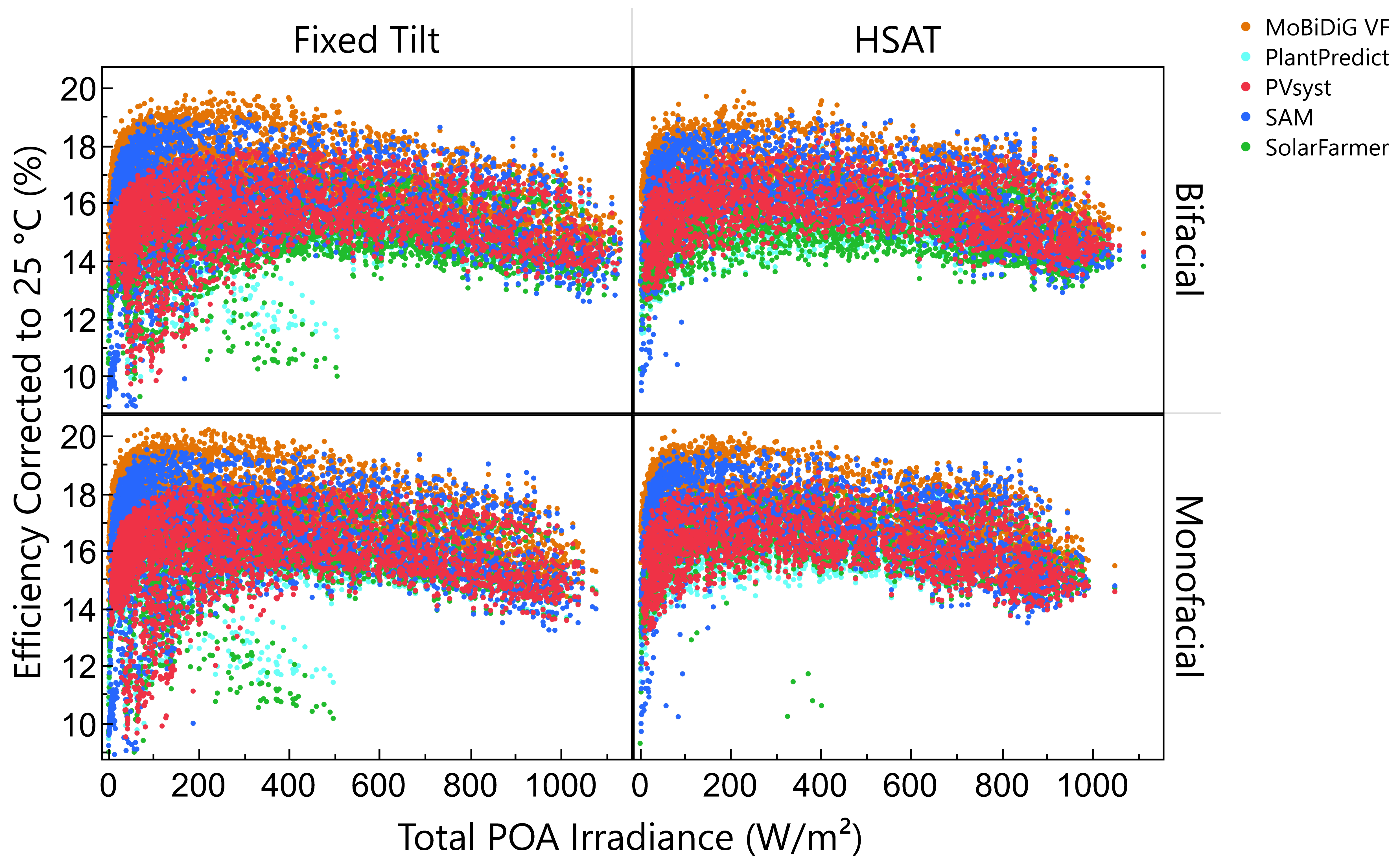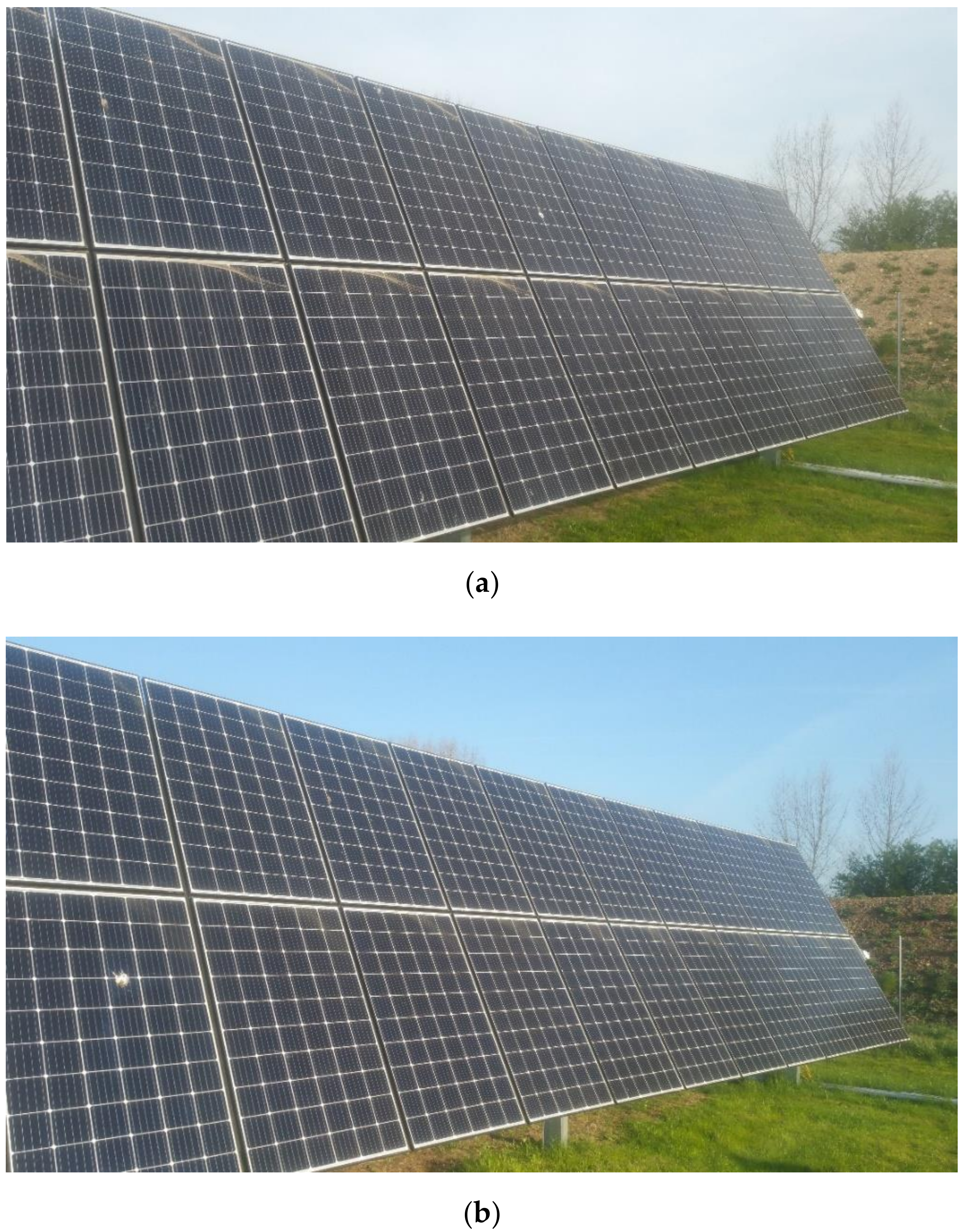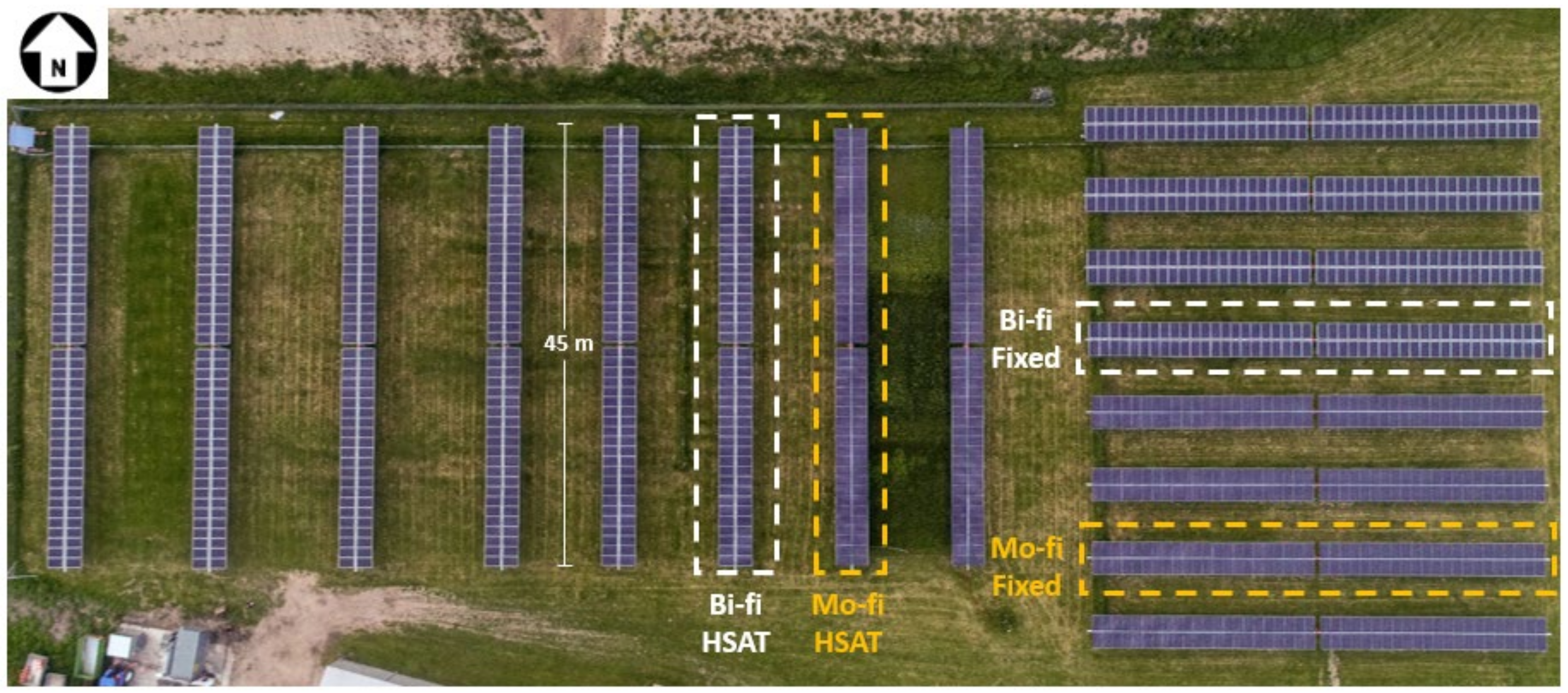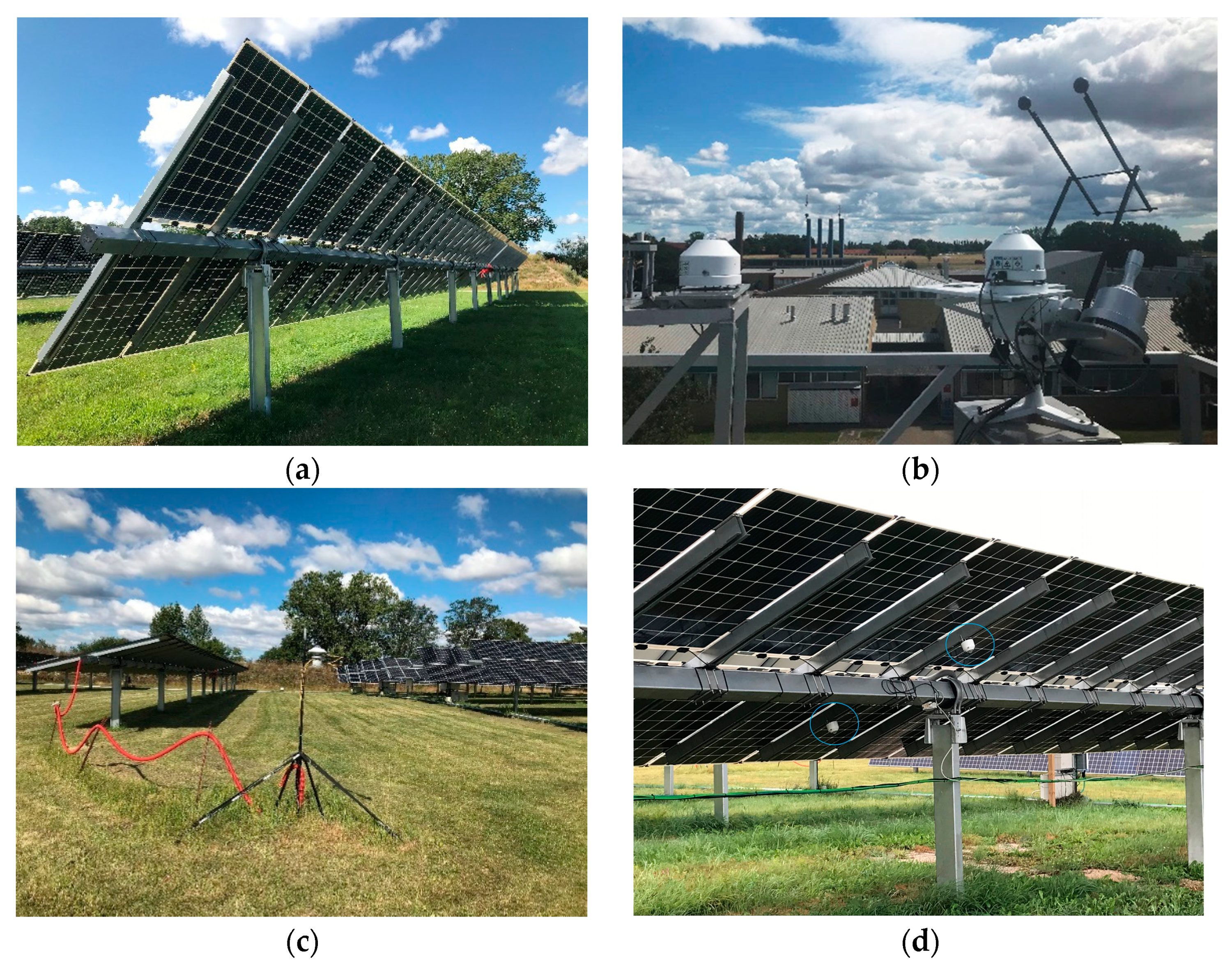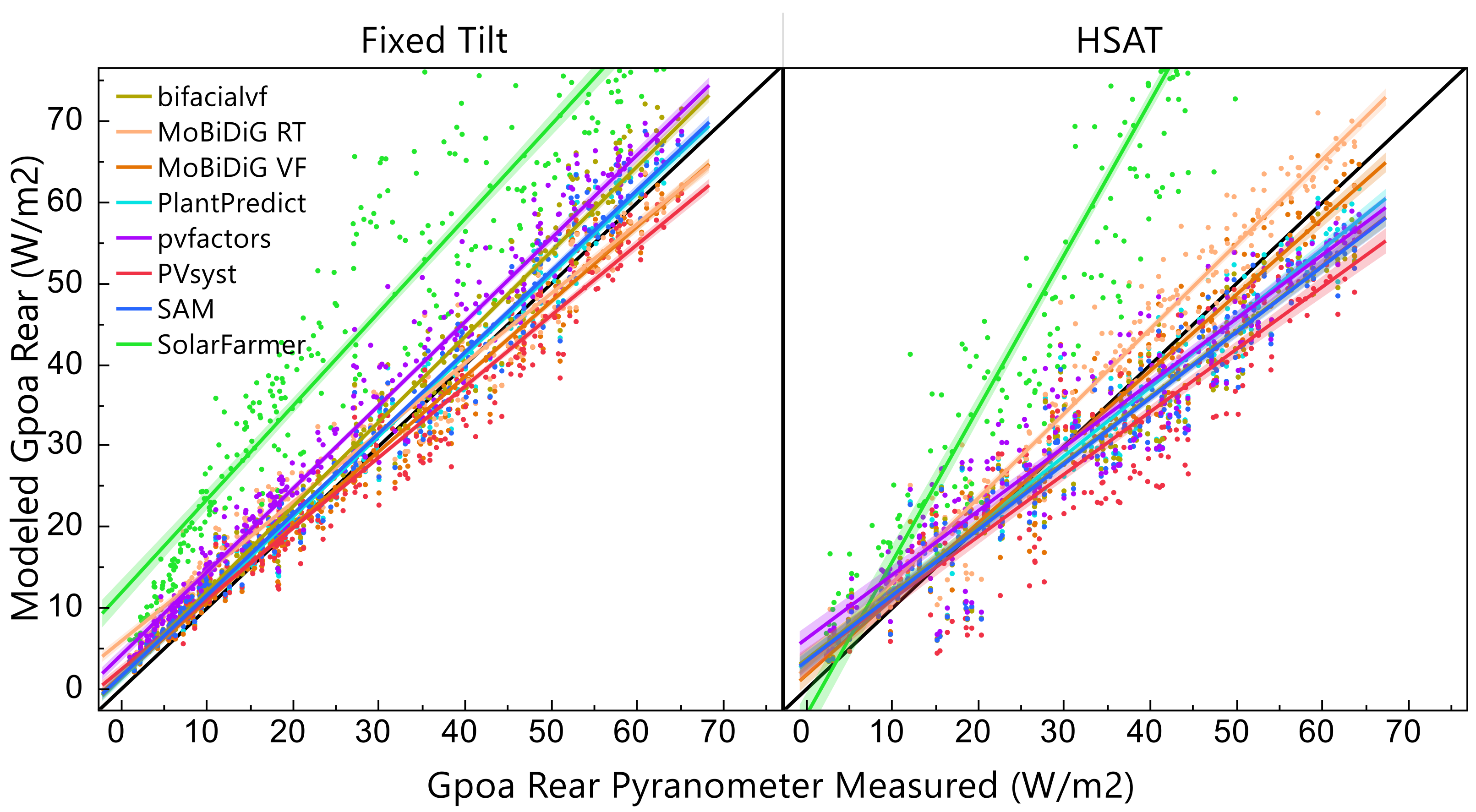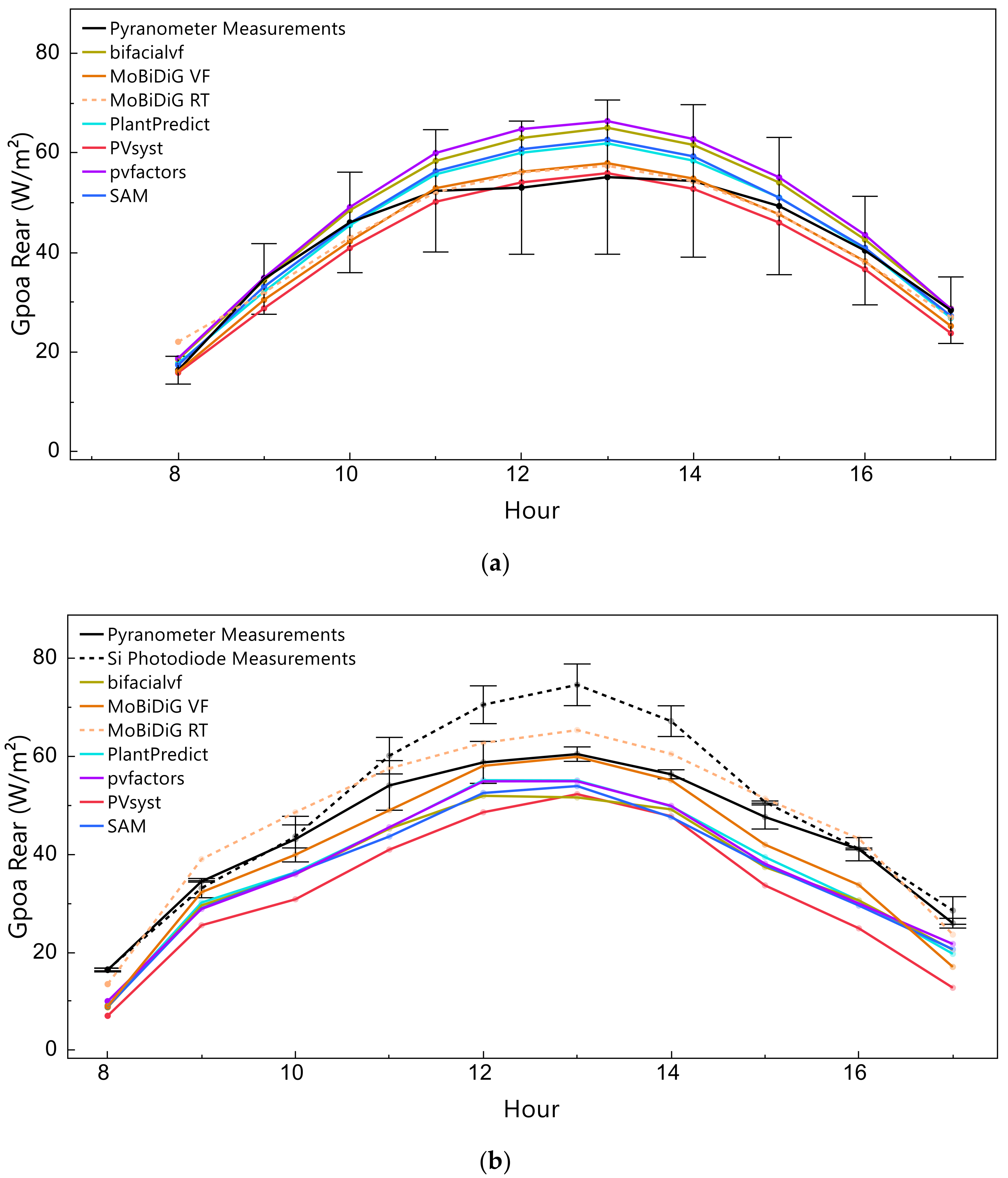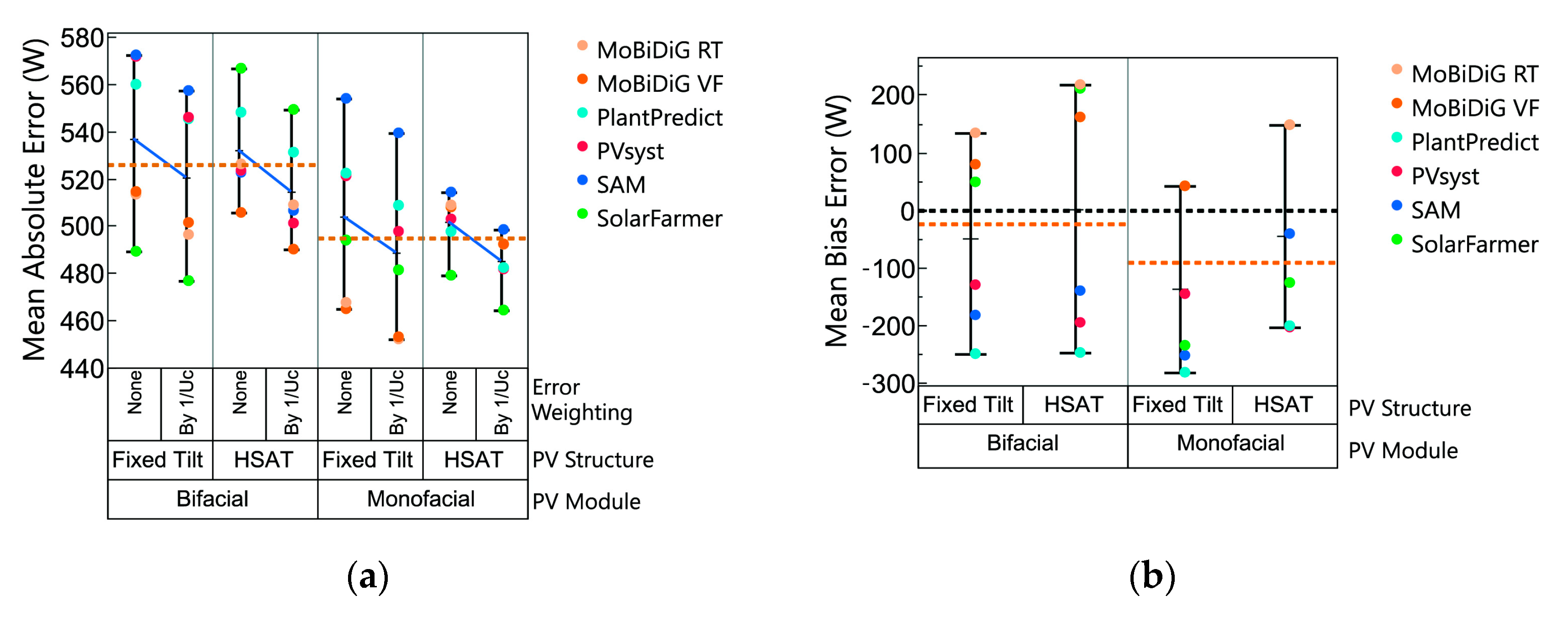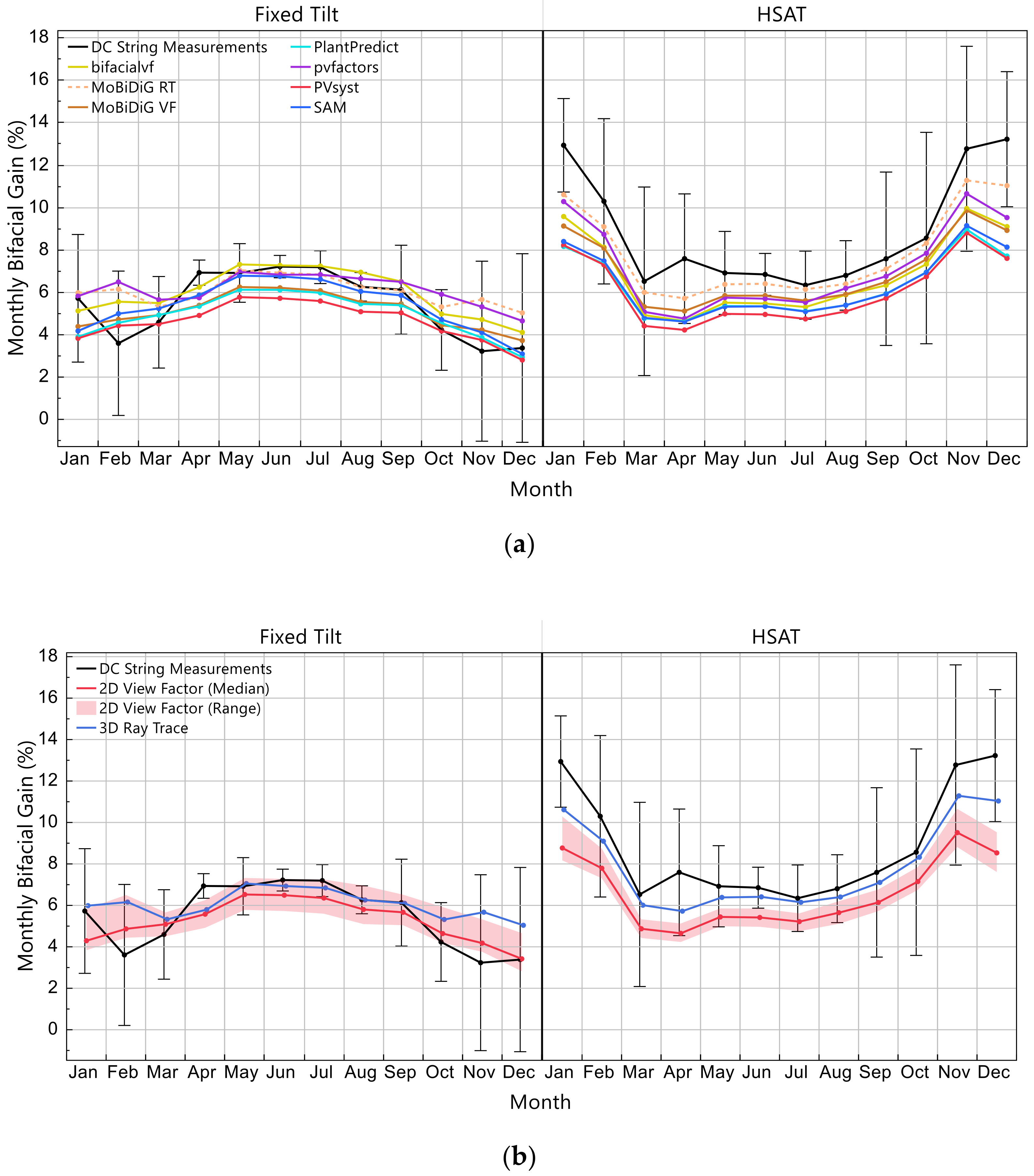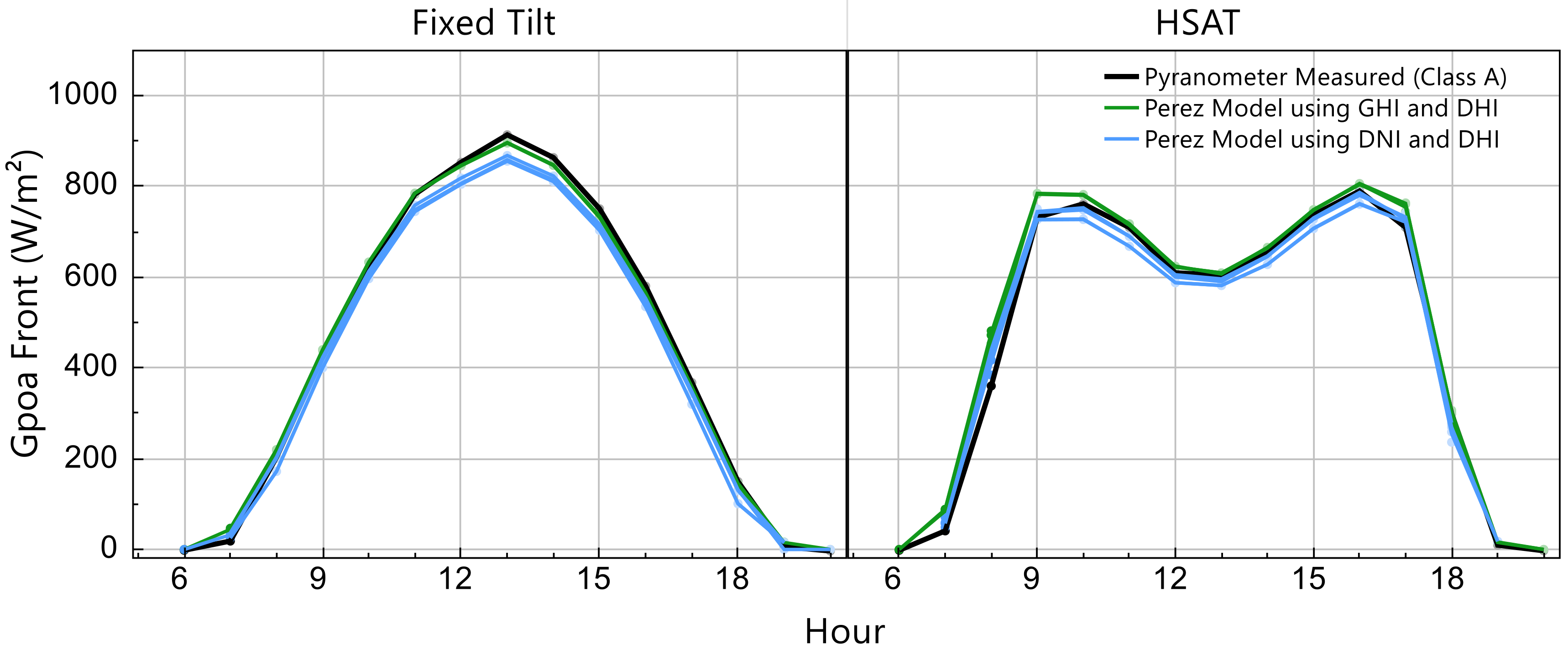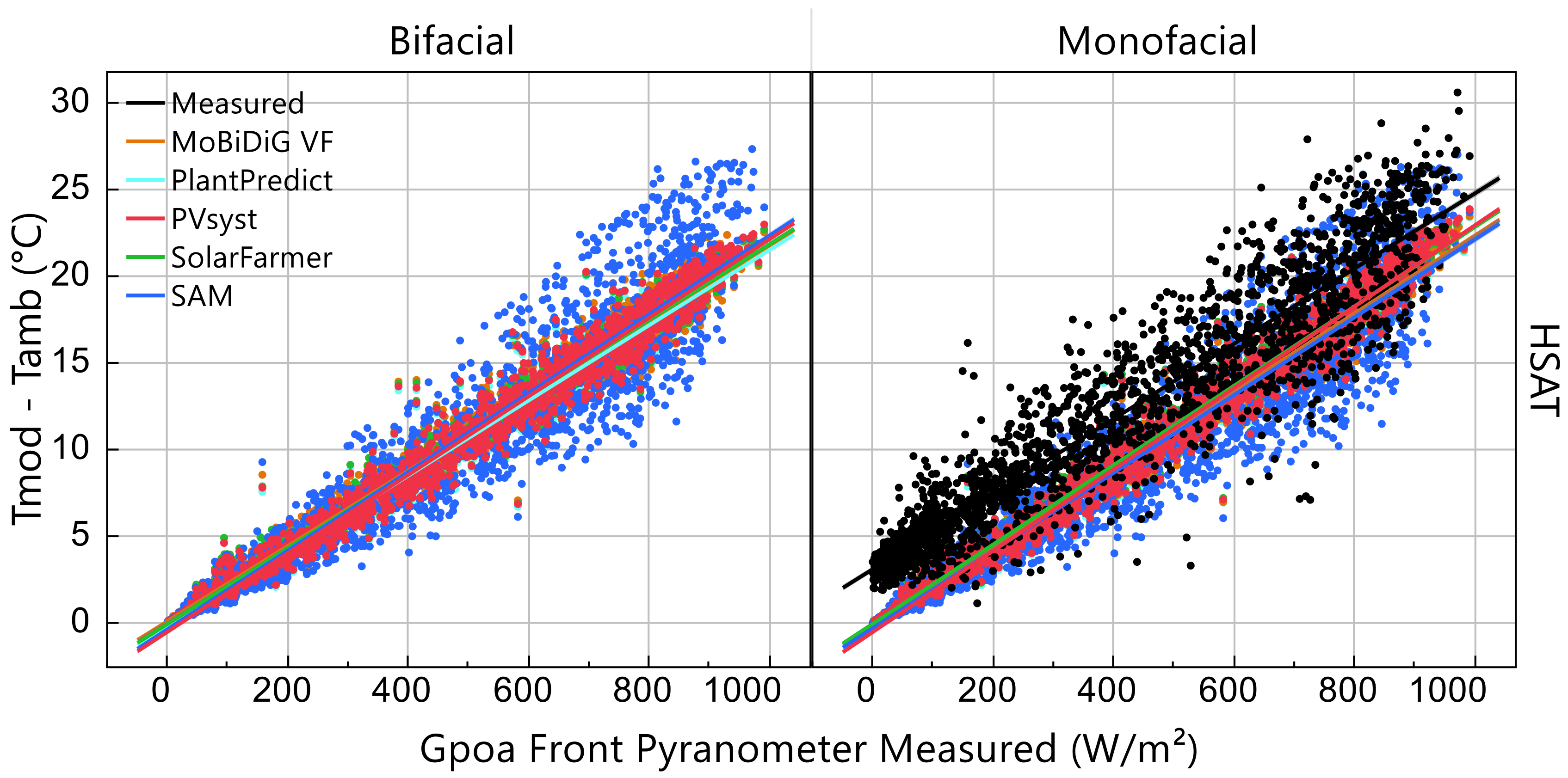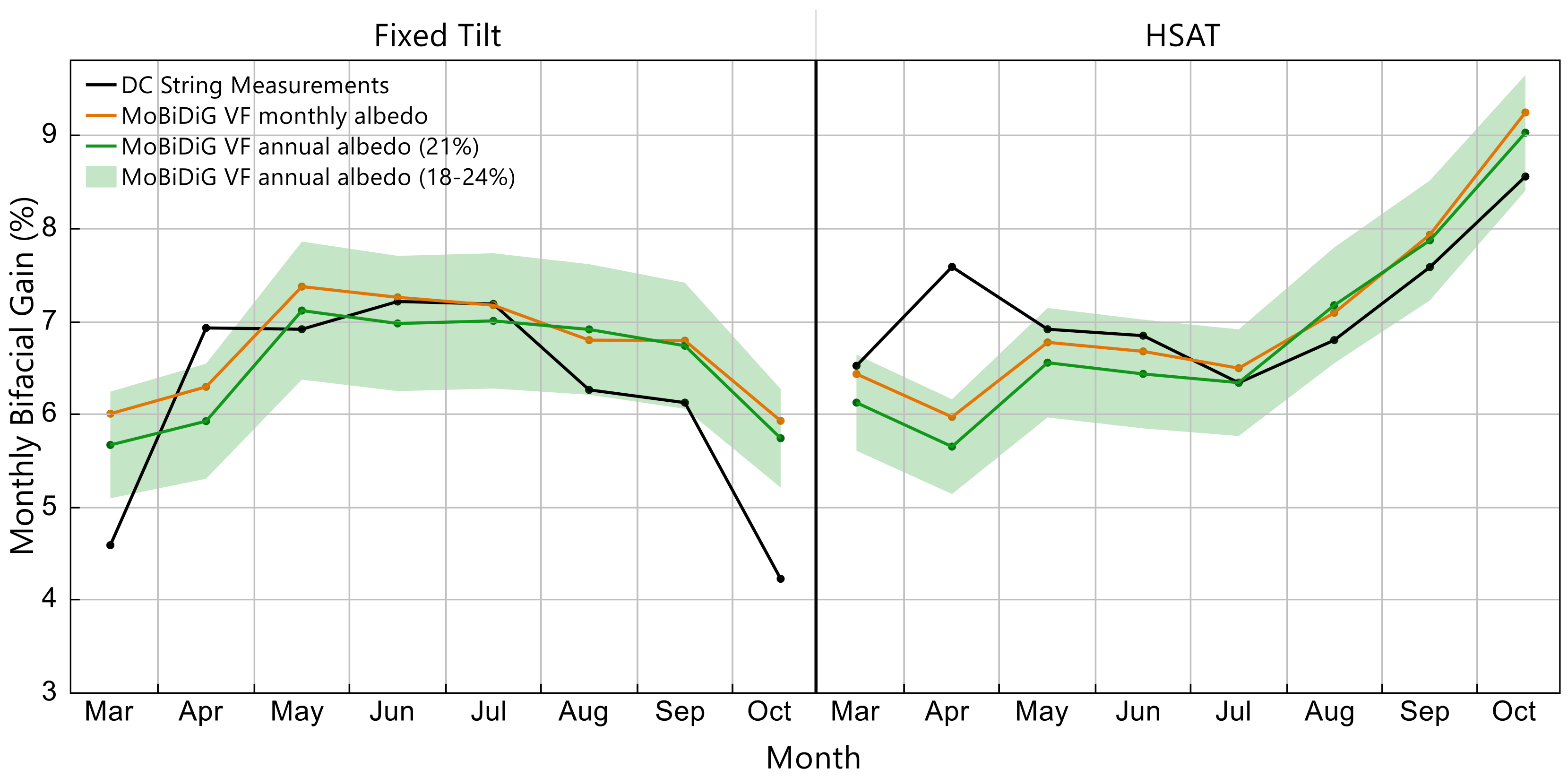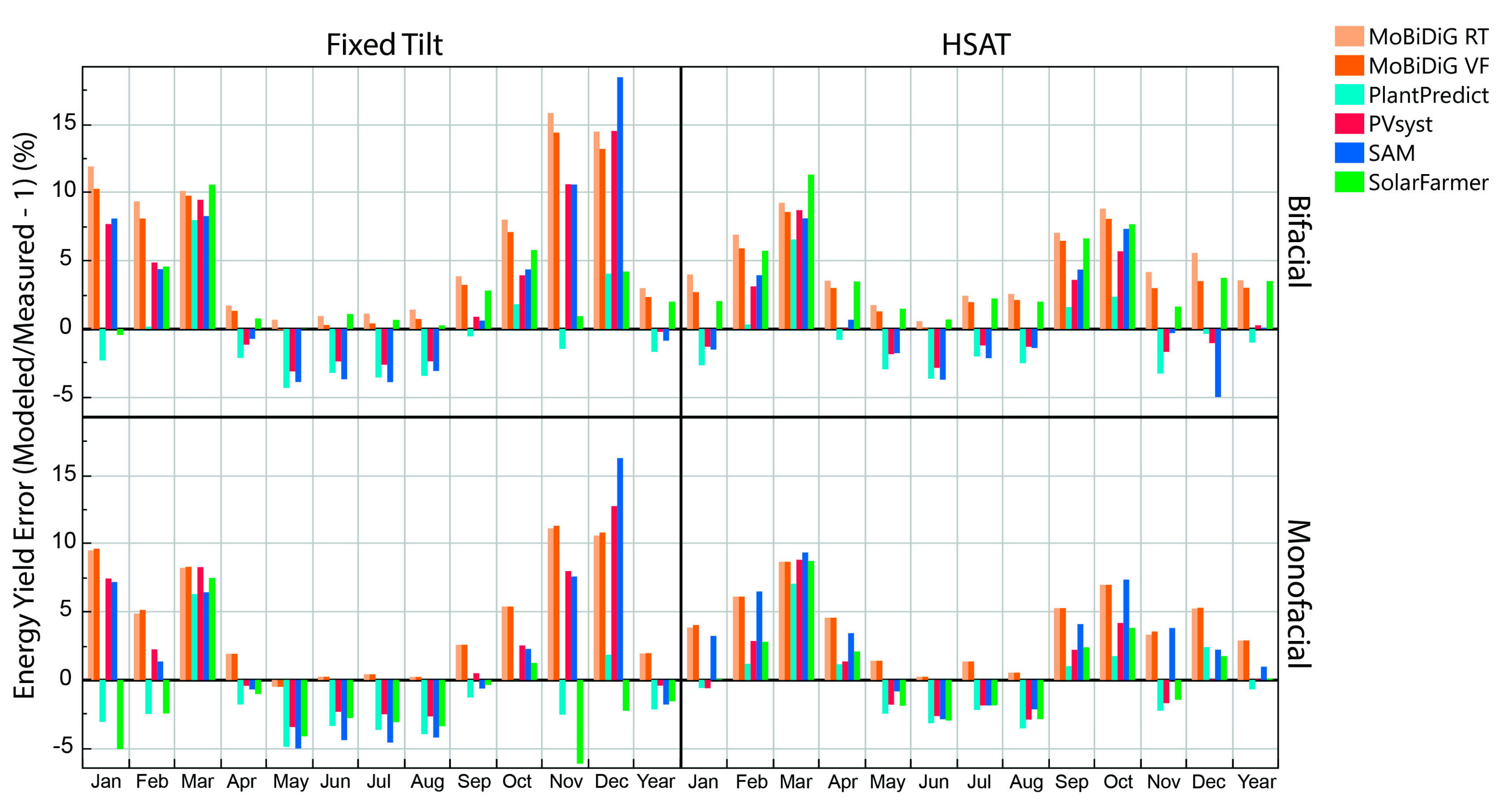3.1. Rear Plane-of-Array Irradiance (GPOA,Rear)
The fundamental challenge in bifacial—as compared to monofacial—PV performance modeling is estimating
GPOA,Rear. Therefore, the discrepancies in simulated bifacial energy production are likely to occur in the derivation of
GPOA,Rear values.
Figure 5 shows one year of simulated
GPOA,Rear values as a function of the average simulated value. The dispersion of simulated values is nearly the same for the fixed-tilt and HSAT system. The range of simulated values among software correlates with the front-side irradiance (R
2 = 0.81–0.85). The range of simulated
GPOA,Rear values is approximately 20 W∙m
−2 at 1000 W∙m
−2 frontside irradiance. In other words, the range of
GPOA,Rear is about 2% of
GPOA,Front. SolarFarmer is highest in this comparison because its integrated approach does not currently consider the obstruction of sky diffuse irradiance caused by neighboring PV rows. Therefore, the ground-reflected irradiance between PV rows is over estimated. To our knowledge, this detail is currently being revised and is expected to be implemented in SolarFarmer versions greater than 1.0.191.2.
A comparison of the modeled
GPOA,Rear during five weeks (21 February–30 March 2020) where measured
GPOA,Rear data are available on the fixed-tilt and HSAT system is shown in
Figure 6. The simulated results include reflection losses at the PV glass–air interface according to the IAM model implemented in each software. The solid black 45° lines in
Figure 5 represent unity to the measurements. The measurements are the average of two MS-40 pyranometers (EKO Instruments, Tokyo, Japan) mounted on the backside of the structure: east and west in the case of the HSAT, top and bottom for the fixed tilt (
Figure 2d).
The trendlines from seven of the eight software agree well with the pyranometer measurements. The mean absolute error (MAE) of these seven software is 2.3–5.2 W∙m−2 for the fixed-tilt system and slightly higher at 3.5–6.7 W∙m−2 for the HSAT system. We analyzed the model residuals as a function of the sun position Gpoa,front and diffuse fraction and found no systematic trends, other than a tendency towards higher percentage errors in GPOA,Rear when GPOA,Front is low.
The peak total irradiance (i.e., sum of
GPOA,Front and
GPOA,Rear) of both system types was approximately 1000 W∙m
−2 during the five-week period shown in
Figure 6. When the magnitude of total irradiance is considered, the MAE of
GPOA,Rear contributes roughly 0.5% uncertainty to the bifacial PV modeling chain. The 3-D MoBiDiG RT simulation over predicts
GPOA,Rear in the HSAT scenario, which could be due to its use of the Perez all-weather luminance model [
59], which is unique among all software tested. The overall poorer model agreement with measurements in the HSAT scenario makes sense considering that tracking introduces additional complexity—and thus additional degrees of freedom for error—at two levels. First, the tracker algorithm implemented by the software is introduced into the comparison and second, the VFs in HSAT simulations are calculated for each change in tilt angle whereas the VFs in fixed-tilt simulations are calculated once for the entire simulation.
An inclinometer sensor mounted on the back of the tracker continuously recorded the tracker roll angle during the test period. We found that the modeled tracker angle was within ±1° of the measured angles 50% of the time, but deviations were as high as 5° during periods of backtracking. We used pvfactors to test the effect that this difference in the roll angle had on simulated GPOA,Rear values. When the measured—as opposed to calculated—angular position was used in the simulation, we found that the mean bias error (MBE) improved slightly from −1.1 to −0.7 W∙m−2, but the MAE, however, changed by less than 0.1 W∙m−2.
The spatial non-uniformity of irradiance on the backside of a bifacial PV array makes it difficult to identify a position for a backward-facing irradiance sensor that is representative of the entire array. Fortunately, research is being conducted on this topic by other authors, although it is still in an early stage [
60]. During clear sky (i.e., low diffuse fraction) days, we observed that the bottom pyranometer can receive nearly twice as much irradiance as the top pyranometer. Therefore, the black unity line in
Figure 6, which represents the average measurement from two sensors, can at times have error bars on the order of ±15 W∙m
−2. On such clear sky days, seven of the eight software studied give
GPOA,Rear results that are within this range (
Figure 7a). In other words, when the vertical spatial non-uniformity of irradiance is considered, the reduced-order complexity 2-D VF models perform reasonably well for fixed-tilt simulations.
In the HSAT scenario, we do not see the same level of model agreement (
Figure 7b). We observed that the irradiance sensor closest to the sky (i.e., western sensor in the morning, eastern sensor in the afternoon) typically receives more irradiance than the pyranometer closest to the ground, which is consistent with the findings of [
22]. We found that the differences between eastern and western
GPOA,Rear measurements on the HSAT system were not as extreme as differences between the top and bottom
GPOA,Rear measurements on the fixed-tilt system. On a clear sky day, we observed differences on the order of 10 W∙m
−2 between western and eastern pyranometers. Although five of eight software agree within 5 W∙m
−2 of each other, none of the same five tools overlap with the measurement uncertainty bars in
Figure 7b. This result could likely change if alternative backside pyranometer locations were chosen. Therefore, the PV industry could benefit from a standardized best-practice protocol for mounting the rear plane of array irradiance sensors in bifacial PV monitoring systems.
The difference between Si photodiode
GPOA,Rear measurements and pyranometer
GPOA,Rear measurements is most apparent at midday, when the tracker is at or near a horizontal tilt. This could be because the Si photodiodes used in this work are calibrated under the air-mass 1.5 global reference spectrum (AM1.5G), but the spectral reflectance of grass deviates strongly from the spectral distribution of AM1.5G [
61]. Particularly, healthy grass has high reflectance in the near-infrared spectrum and very little reflectance in the visible spectrum where the AM1.5G spectrum peaks. It is well known that the output of silicon PV devices calibrated under the AM1.5G spectrum will increase as the observed spectrum “red shifts” [
62,
63]. This can explain why the Si photodiode measurements are higher than the pyranometer measurements around midday when the tracker is near horizontal, and the sensor’s field of view is primarily encompassed by grass, not the sky. However, the spectral response of the Si photodiodes is reasonably well matched to that of the bifacial PERC module’s rear side, and for this reason, the readings from this sensor type could be more representative of the effective irradiance received at the backside of the PV array. Indeed, further research is needed on the benefits of silicon radiometers (reference cells) versus pyranometers in bifacial PV monitoring applications.
3.2. DC Power
Figure 8 shows one year of modeled versus measured DC string power of four PV configurations as simulated by six software. Good correlation is observed in all 24 regressions (R
2 = 0.99), but residual errors can exceed 5 kW (20%) in some cases. When such large errors are observed, the error is similar for all six software, which indicates an unidentified issue with the meteorological measurements and/or the electrical monitoring system. The DC electrical monitoring system measures string-level voltage and current independently of the inverter. The galvanically isolated data acquisition boards are a commercially available string.bloxx solution from Gantner Instruments (Rodgau, Germany). From the specifications, we determined the uncertainty of the DC power measurements as ±0.5% at the full scale. The dashed black lines in
Figure 8 are drawn at ±4.5% from the solid black unity line and depict the GHI measurement uncertainty on a clear day at solar noon (±4%) and the uncertainty of the power measurements (±0.5%). All 24 trend lines in
Figure 8 are within this boundary at measured power levels greater than 7 kW.
Figure 9 shows the model errors from
Figure 8 in the form of cumulative distribution functions (CDFs). The slopes of all 24 CDFs in
Figure 9 are steepest around approximately ±500 W, which indicates that the majority of errors are within this range. CDF shifts in the positive X-axis direction indicate that a modeling tool has a tendency toward higher DC power predictions, while shifts in the negative x-axis direction indicate a tendency toward more conservative DC power predictions. With this in mind, the bifacial fixed-tilt and HSAT simulations reveal two groups: PlantPredict, PVsyst, and SAM showing nearly identical CDFs; and MoBiDiG RT, MoBiDiG VF, and SolarFarmer showing very similar CDFs. The former group has a tendency toward negative bias and the latter group a tendency toward positive bias. In the case of the bifacial HSAT simulation, the reason for this two-group split could be attributed to the latter group yielding the highest estimates of
GPOA,Rear (
Figure 6). In the case of the bifacial fixed-tilt simulation—and both monofacial simulations—the explanation is not so clear and therefore likely not attributable to a single difference in submodeling steps but rather due to the differences accumulated in multiple submodels. We performed regressions of the DC power residuals as a function of measured variables, such as diffuse light fraction (
DHI/
GHI), sun position (zenith and azimuth), and
GPOA,Front. This exercise revealed no significant correlations (R
2 < 0.25) or systematic trends, other than a trend of larger absolute errors during times of high solar irradiance.
Figure 10 shows two variability plots that summarize the annual mean absolute errors (MAEs) and mean bias errors (MBEs) of the four PV system types simulated by six software. The dashed orange lines in each variability plot represent the average modeling error of the bifacial and monofacial system types and indicate a 30 W higher MAE in bifacial simulations. The slightly higher MAE can be explained simply by the fact that the bifacial arrays produce about 5% more energy on an annual basis than the monofacial arrays. When the MAE is normalized to the average power produced by each system type over the year, we found that the normalized error is about 0.25% higher for bifacial simulations versus monofacial simulations. This difference is likely driven by the contribution of
GPOA,Rear. In terms of the average MBE, bifacial simulations are about 90 W higher than monofacial simulations but closer to zero bias than the monofacial simulations. Within the context of the results obtained from the site studied here, we conclude that the accuracy of bifacial PV simulations is not significantly different than monofacial PV simulations.
Figure 10a shows the MAE calculated using two approaches: (1) without error weighting and (2) by weighting the error with the inverse uncertainty (1/U
C) of the solar radiation measurements during each hour of energy production. In approach (2), the errors are weighted by either the
GHI uncertainty or DNI uncertainty, depending on the data used in the transposition step, and the sum of all error weights equals one. The rationale behind the 1/U
C weighting in approach (2) is that uncertainty in solar radiation measurements directly impacts simulated PV power, which ought to be accounted for in error analyses. As expected, weighting the error by a factor of 1/U
C reduces the MAE, but the reduction is small at about 20 W, or 0.2%.
3.3. Bifacial Gain
Figure 11 shows the monthly bifacial gain from five software that are capable of simulating electrical performance. The black lines in each plot show the monthly results from the DC string measurements. The error bars show the inner quartile range of daily measured bifacial gains observed in each month. The daily bifacial gains in winter fluctuate greatly because the daily energy production in winter can be an order of magnitude less than in summer months: This variability is illustrated with the wider error bars in winter. Recall that the measured results are normalized with the I-V measurements made at DTU per Equation (1). If the normalization was instead made using the manufacturer’s nameplate rating, the measured bifacial gain according to Equation (1) would be 1.5% higher than what is shown. This difference can significantly affect the economics of project decisions that are made based on an expected bifacial energy gain.
The measured monthly bifacial gain on the fixed-tilt system is between 4.3% and 7.3% from March to October. Meanwhile, the bifacial gain on the tracker is consistently higher, between 6.6% and 8.5% during the same months. The higher bifacial gains observed on the HSAT are likely due to the wider 12-m spacing between rows (GCR = 0.28) versus the narrower 7.6-m spacing on the fixed-tilt system (GCR = 0.4), which creates more self-shading within the inner rows of the fixed-tilt field.
From November to February, the measured bifacial gain on the two system types shows opposing trends, wherein the HSAT system shows an increase and the fixed-tilt system shows a decrease. These months were characterized consistently as cloudy skies with mean monthly diffuse fractions between 88% and 94%. The works of other authors have demonstrated that bifacial gain will increase as the fraction of diffuse light increases [
64], which can explain the higher bifacial gain on the HSAT system in winter. It also been shown that bifacial PV systems require higher tilt angles to capture the benefit of such diffuse conditions [
65]. This can explain why the simulations and the measurements in winter show lower bifacial gains on the fixed-tilt system (25°) than the HSAT system (±60°).
The simulated bifacial gain values largely follow the trends of the measurements, but the most notable exception is the fixed-tilt system in winter (November through February). This discrepancy is likely due to the significant amount of inter-row shading on the fixed-tilt system from November to February. The fixed-tilt system has a shade angle (at solar noon) of 16°, but on the winter solstice, the sun elevation peaks at 12°. Therefore, the fixed-tilt rows are partially shaded at practically all times in December and January. In fact, negative bifacial gains were measured in November and December on the fixed-tilt systems. Such an incongruous result points toward issues in the measurements rather than the shade-loss models. A visual inspection on a clear winter day near solar noon confirmed that there was more inter-row shading on the bifacial arrays than on the monofacial arrays. This is attributed primarily to the torque tube gap on the bifacial arrays, and the lack of such a gap on the monofacial arrays. The torque tube gap on the bifacial arrays (
Figure 2a) places the bifacial modules approximately 5 cm higher than modules on the monofacial arrays that completely cover the torque tube (
Figure A2). This slight differentiation in structural geometry may not have been simulated sufficiently in the software.
Another notable discrepancy between the model and measurement is seen in April when a small spike in bifacial gain is observed on both the fixed-tilt and HSAT system. The trend in modeled bifacial gains from March to May indicate that the measured bifacial gain in April is overstated by as much as 1.5%. We believe the higher measured bifacial gain in April was caused largely by extraordinarily high pollen counts in late April 2019, which caused non-uniform soiling on the PV arrays, and ultimately more power loss in the monofacial than bifacial systems. We observed that the daily bifacial gains were between 10% and 20% from 23–26 April 2019, which corresponds to the dates of the soiling event (
Figure A2). A significant rainfall event occurred on 27 April 2019 at which point more modest and typical bifacial gains resumed. This artifact highlights the challenge of curating high-quality data acquisition in large-scale PV test sites.
Please note that the bifacial gain results from SolarFarmer are not presented in
Figure 11 because the overestimation of
GPOA,Rear shown in
Figure A2 causes a 2–4% upward bias in bifacial gain as compared to the other tools, which use the PVsyst 1-diode model (i.e., PlantPredict and PVsyst). This result conflicts with our previous work [
27], which showed SolarFarmer results mostly within 1% of the measured bifacial gain, while PlantPredict and PVsyst results were 3–4% low to the measured bifacial gain. The reason for this discrepancy is that the present work uses a 1-diode model parameter set based on laboratory measurements made at irradiances from 200–1000 W∙m
−2 (noted as ‘Parameter Set 1’ in
Figure 11b) while our previous work used a parameter set based on measurements made only at STC (noted as ‘Parameter Set 2’ in
Figure 11b). The improved agreement of ‘Parameter Set 1’ shown here is attributed to the fact that this parameter set more accurately predicts performance at low-light conditions (<400 W∙m
−2) than does ‘Parameter Set 2’. This finding is in agreement with the findings and recommendations of other authors [
66,
67].
Figure 12 shows the simulated bifacial gain according to the
GPOA,Rear to
GPOA,Front ratio (Equation (2)). The agreement among the different software is similar regardless of whether the bifacial gain is calculated using the optical gain (Equation (2)) or the electrical performance (Equation (1)), with the exception of HSAT results in winter, where better agreement among software is seen using Equation (2). The larger discrepancies between HSAT simulations in winter using Equation (1) could be due to the different backtracking and shade-loss algorithms used by the software. Equation (2) results in better agreement with the fixed-tilt system measurements in winter, which indicates that inaccuracies in the shade-loss models are likely the result of the significant winter deviations shown in
Figure 11.
Figure 12b shows the results grouped by whether
GPOA,Rear is calculated using a 2-D VF or 3-D RT approach. When visualized in this manner, it becomes clear that the 3-D RT approach follows the measured bifacial gain most closely for the HSAT simulation, within 0.5% of measurement for most months outside of winter. The 3-D RT model also matches well, typically within 0.5%, with the bifacial gain measurements on the fixed-tilt system. However, 2-D VF models, such as the one integrated in SAM, compared equally well to field measurements. Indeed, the measured bifacial gain shown in
Figure 12 is influenced by the value of
Bifiloss. The static
Bifiloss values used here, in actuality, change dynamically over the day with the prevailing conditions [
19,
57,
58]. All the commercial software tested here has the capability to use only a single value. This simplification offers room to improve the accuracy of the bifacial PV performance simulation tools used in industry today.
3.4. Frontside Plane-of-Array Irradiance (GPOA,Front) and Module Temperature (TMOD)
PV project developers and investors are often interested in bottom-line figures, such as performance ratios, specific yields, and, in the case of bifacial PV, the bifacial gain. However, comparing simulations to measurements at such a high level is often not meaningful without first analyzing the performance of key submodeling steps. This section builds on this analysis, which started in
Section 3.1 with an assessment of
GPOA,Rear, and shows how the simulations compare to onsite front-side plane-of-array irradiance (
GPOA,Front) and back of module temperature (T
MOD) measurements.
Figure 13 shows an overlay of the simulated and measured
GPOA,Front on a cloudless day. The trends shown here are representative of the results from clear sky days within the test period. The plot is color coated by which combination of solar radiation measurements is used in the Perez transposition model. Lower
GPOA,Front estimates (≈40 W∙m
−2) are seen at midday when
DNI is used in the transposition step. On an annual basis, the MBE is between 11 and 13 W∙m
−2 when
GHI is used in transposition, and when
DNI is used in the transposition step, the MBE is between −7 and 5 W∙m
−2. These rather large differences in results using
DNI and
DHI versus
GHI and
DHI could be the result of measurement issues with either the
GHI pyranometer or
DNI pyrheliometer. However, it is worth reiterating that weekly maintenance is performed at the weather station, and that the
GHI,
DHI and
DNI data passed the quality checks recommended by the BSRN [
46]. Additionally noteworthy in
Figure 13 is how there are considerable deviations among the tools that use the same
DNI and
DHI data as input, a result that is similar to that of other authors [
28].
Since the front-side irradiance constitutes 92% or more of the total irradiance for half of the timestamps in the bifacial simulations, one would suppose that software that uses
DNI in the transposition step would tend to underpredict DC power. However, this turns out to not always be the case. For example, MoBiDiG is one such tool that uses
DNI, and this tool was shown in the CDF plots of
Figure 9 to
overpredict DC power of all PV system types compared to the other five software. SAM is another such tool that uses
DNI, but the results in
Figure 8 and
Figure 9 show that SAM tends to predict marginally higher DC power values than the tools that use
GHI but only in HSAT simulations. The underprediction of
GPOA,Front by MoBiDiG and SAM could be compensated by their tendency to overpredict electrical performance at irradiance conditions <400 W∙m
−2, which is due to their use of the De Soto versus PVsyst 1-diode model (
Figure A1). This demonstrates how analyzing the accumulated errors at various submodeling stages and their subsequent impact on energy yield is not always a straightforward process.
Figure 14 shows the difference between module temperature and ambient temperature versus
GPOA,Front. This difference between module and ambient temperature is known to be essentially linear with respect to the in-plane irradiance with a slope proportional to the U
0 coefficient used. The variations around the regression lines are due to the assumptions for convective heat transfer in the U
1 coefficient. A notable difference in
Figure 14 is the module temperature predicted by SAM, which is simply due to SAM’s use of the NOCT versus Faiman model. The T
MOD measurement comes from one 4-wire resistance temperature device (RTD) affixed to a single cell on the backsheet of a module within the array; no translation from back of module (backsheet) to cell temperature is made in
Figure 14. The monofacial results of
Figure 14 show that the simulations tend to underpredict the measured back of module temperature by 2–3 °C, but errors are often greater than 5 °C. Unfortunately, T
MOD sensors were never installed on the bifacial arrays, and as such, only monofacial temperature measurements are available.
All software studied here implement simplified steady-state thermal models that assume the PV array operates at a homogenous temperature, which can lead to discrepancies with measured values. Although healthy (i.e., non-damaged) modules are typically assumed to have homogenous temperatures within an array [
68], cell temperatures are known to vary within a healthy module [
69]. Therefore, the cell on which the RTD is placed may not be representative of the average cell temperature within the array, which is a potential source of error when comparing to modeled values.
Appropriate values for device-specific thermal parameters, and the methods to acquire them from measurements, have been the subject of discussion and debate in the PV community [
70]. Therefore, we performed a sensitivity analysis of the U
0 and U
1 thermal coefficients using the MoBiDiG VF tool. Our sensitivity found that the MBE of simulated monofacial DC power was minimized using U
0 and U
1 parameter values of 24 W∙m
−2∙K
−1 and 1.6 W∙m
−3∙K
−1∙s, respectively. The sensitivity analysis showed that the best agreement between the modeled and measured module temperature would require U
0 and U
1 values near 20 W∙m
−2∙K
−1 and 0 W∙m
−3∙K
−1∙s, respectively. Since these values are below the lower boundary of published values that we are aware of for open-air mounted PV systems [
54,
71], it seems that the cell on which the RTD is placed is not representative of the average cell temperature within the array.
3.6. Monthly and Annual Energy Production
With the results from several key intermediary modeling steps presented, we conclude the results section with a comparison of the modeled and measured monthly DC energy. In
Figure 16, the monthly and yearly errors in energy predictions across all four PV system types are shown. Please note that roughly 75% of the total annual energy is produced between April and August. With just 25% of the annual energy produced between September and March, errors during these months tend to be larger on a percentage scale. An interesting result in
Figure 16 is that on a monthly basis, PlantPredict, PVsyst, SAM, and SolarFarmer fluctuate between negative and positive bias relative to the measurements, sometimes with monthly deviations greater than 5%. However, on an annual basis, all tools simulate the four PV systems within 3.5% or less of measurements, and in some cases, the annual error is less than 1%. This is a rather positive result considering the uncertainty of the solar radiation measurements and the electrical monitoring system.
The accuracy of annual results from PVsyst and SAM shown in
Figure 16 are in fact better than those published by [
75], which could be because the parameters and loss factors used here were thoroughly calculated rather than using default values. On an annual basis, results from PlantPredict match PVsyst within 0.7% to 2.0%, which is a slightly larger deviation than that presented in [
31] for Cadmium Telluride technology, but the larger differences here could be due to the use of different IAM models to describe reflection losses and/or the introduction of
GPOA,Rear. The annual MoBiDiG results are between 2% and 3% above measurements, which is higher than the ±1% published in [
14] for most static-tilt configurations, but agreement could improve if, for example, the DeSoto parameter set was modified such that the modeled DC efficiency was lowered at low-light conditions (
Figure A1).
Finally, a word on the accuracy of bifacial versus monofacial simulations: The difference between the annual energy yield error in bifacial versus monofacial simulations is 1% or less, for five of six software. The outlier is SolarFarmer, which shows larger differences between its bifacial and monofacial simulations, but this is simply due to the overestimate of
GPOA,Rear mentioned previously. The annual errors in bifacial and monofacial simulations are no more than 0.5% different when performed in MoBiDiG VF, PlantPredict, and PVsyst. This result is in accord with the results presented in
Section 3.1, which showed a deviation of roughly 0.5% between modeled and measured
GPOA,Rear values when considering the contribution of
GPOA,Front.
